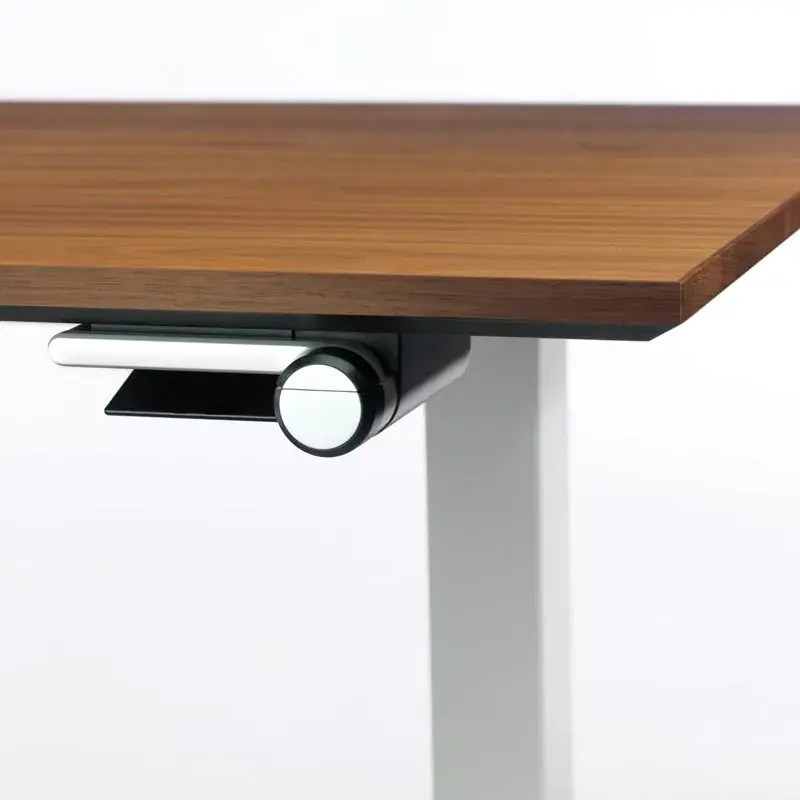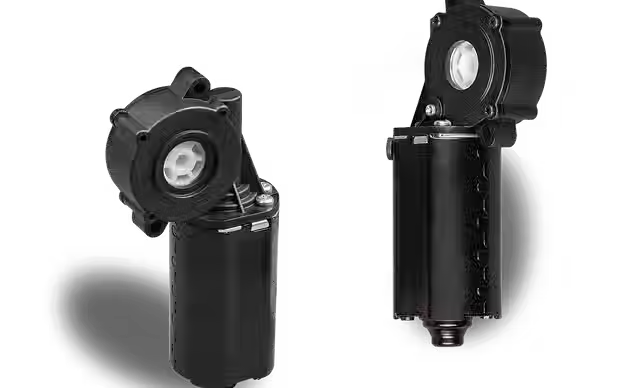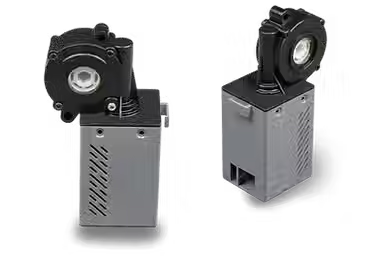The Ultimate Guide to Electric Motors and Speed Control in Desk Applications
- Xie
- May 9
- 9 min read
Updated: May 15

As the modern workplace evolves, the demand for ergonomic and smart furniture solutions has skyrocketed. At the forefront of this trend is the height-adjustable desk—a staple in both corporate and home office environments. These desks are no longer considered a luxury, but a necessity for promoting employee well-being, productivity, and dynamic workstyles.
Driving the smooth motion behind these sit-stand desks is one essential component: the electric motor. Among various motor types, DC motors stand out due to their efficiency, compact design, quiet operation, and controllable speed characteristics. Whether you're an office furniture OEM, a product development engineer, or simply a curious reader interested in electromechanical systems, understanding how DC motors function is essential to designing and choosing the right system.
This is where MEI MOVE enters the picture. As a globally respected manufacturer of DC motors for desks, MEI MOVE provides advanced motion solutions that are trusted by leading ergonomic furniture brands worldwide. With over a decade of experience in precision engineering and electric motor design, MEI MOVE delivers high-performance, customizable, and energy-efficient motor systems for adjustable desks and related furniture.
In this ultimate guide, we will delve deep into the history and invention of DC motors, explore where DC motors are used across industries, explain the mechanics and advantages of electric motors with speed control, and highlight MEI MOVE’s brushless DC gear motor technology. We’ll also cover practical advice for OEMs and answer common questions in our FAQ section.
By the end of this extensive article—spanning over 4000 words—you’ll gain a complete understanding of how electric motors with speed control power the next generation of height-adjustable furniture, and why MEI MOVE is your ideal partner in motion solutions.
MEI MOVE Electric Motor & Speed Control Guide:
Who Invented the DC Motor?
The DC (Direct Current) motor has a rich history that dates back to the early 19th century—a time of rapid technological experimentation and discovery. The invention of the DC motor is widely credited to Thomas Davenport, an innovative American blacksmith from Vermont. In 1834, Davenport successfully built the first practical DC motor capable of powering small mechanical devices. His pioneering motor was powered by a non-rechargeable battery and was used to operate a small model car on a circular track, demonstrating the feasibility of using electricity to create continuous rotary motion.
Although Davenport’s invention was rudimentary by today’s standards—lacking advanced materials, precision engineering, or energy efficiency—it was a groundbreaking step forward. His work laid the essential foundation for the electric motors that power modern industry, transportation, and daily life. His motor used a simple design consisting of a rotating electromagnet and a commutator, which helped convert electrical energy into consistent mechanical motion. Importantly, this principle of using direct current to generate controlled rotation is still at the core of DC motor technology today.
Despite financial hardships and limited access to resources, Davenport went on to secure the first U.S. patent for an electric motor in 1837, making his contribution not only innovative but also legally recognized. His work would inspire generations of inventors and engineers to refine, commercialize, and scale electric motor technology, eventually leading to its integration in everything from industrial machinery to the ergonomic height-adjustable desks we use in modern offices.
Key Milestones in DC Motor Development
1832–1834: Thomas Davenport invents the first working DC motor.
1860s: Improvements in commutators and armature windings.
Late 1800s: DC motors become common in trams, printing presses, and other machines.
20th Century: Widespread industrial adoption with the rise of speed control techniques.
21st Century: Emergence of brushless DC motors for high-efficiency applications like sit-stand desks.
Where Are DC Motors Used?
DC motors are incredibly versatile and used across many industries and consumer applications. Their ability to provide speed control and maintain efficiency under varying loads makes them ideal for numerous scenarios.
Common Applications of DC Motors
Office Furniture: In height-adjustable desks and ergonomic chairs.
Medical Equipment: Hospital beds, dental chairs, and mobility devices.
Automotive: Power windows, adjustable seats, windshield wipers.
Industrial Automation: Conveyor belts, robotic arms, and precision tools.
Consumer Electronics: Drones, electric toothbrushes, and toys.
Renewable Energy: Small-scale wind turbines and generators.
As more industries adopt ergonomic and automated solutions, DC motors continue to see expanding applications.
Understanding Electric Motors
An electric motor converts electrical energy into mechanical motion. They come in many forms, but DC motors are uniquely suited for applications where variable speed and control are important.
Types of Electric Motors
AC Motors: Powered by alternating current, typically used in high-torque or continuous-load systems.
DC Brushed Motors: Use brushes and a commutator to transmit electrical current. More affordable, but require maintenance.
Brushless DC Motors (BLDC): Use electronic controllers instead of brushes. Quieter, longer-lasting, and more efficient.
Stepper Motors: Used in applications requiring precise positioning, such as 3D printers and CNC machines.
MEI MOVE focuses on DC motors, particularly brushless DC gear motors for adjustable desks, ensuring quiet operation, longevity, and smooth transitions.

Why Speed Control Matters in Desk Motors
Speed control refers to the capability to precisely regulate the rotation speed of an electric motor to suit the specific demands of its application. In the context of height-adjustable desk systems, speed control plays a critical role in delivering a seamless and reliable user experience. This feature goes far beyond basic functionality—it directly impacts the performance, safety, and user satisfaction associated with modern ergonomic furniture.
Smooth Height Adjustment: Accurate speed control ensures the desk transitions between height settings fluidly and without interruption. It prevents jerky or abrupt movements, which could not only damage internal mechanical components but also disturb items on the desktop, such as monitors, laptops, or beverages. Smooth motion also adds a premium feel to the desk’s operation, reflecting the overall quality of the furniture system.
User Comfort: Speed-controlled motors minimize vibration and operational noise, which is especially important in open office layouts or home environments where silence and focus are valued. A quiet motor enhances the workspace atmosphere and ensures users can adjust desk height without distracting themselves or others.
Precise Positioning: In many desk systems, users can save preferred height levels through memory preset functions. These presets depend on the motor’s ability to stop at precise positions consistently. High-accuracy speed control allows the desk to return to the exact saved height every time, supporting personalized ergonomic setups and reducing the need for manual fine-tuning.
Safety: Reliable speed control enhances the safety of sit-stand desks. By managing acceleration and deceleration smoothly, the motor helps prevent sudden movements that could pose a risk of pinching, falling objects, or user injury. This is especially crucial in environments with children or shared office spaces where multiple users interact with the same equipment.
Overall, effective speed control transforms a basic motorized desk into a smart, safe, and user-friendly system. At MEI MOVE, our DC motors are engineered with advanced speed control algorithms and feedback systems to ensure dependable and precise performance in every use case—from home offices to large-scale corporate installations.
How Speed Control Works
Speed control in electric motors is typically achieved through:
Pulse Width Modulation (PWM): A technique that varies the duty cycle of a digital signal to control voltage.
Closed-loop Feedback Systems: Sensors monitor actual motor speed and make real-time adjustments.
Microcontroller-based Drivers: Offer programmable speed, direction, and braking.
MEI MOVE motors integrate advanced speed control systems optimized for furniture use, including overload protection and energy-saving features.
Components of a DC Motor System for Desks
To better understand the functionality of MEI MOVE’s motors, consider the main components involved:
Motor Unit – Converts electricity into mechanical energy.
Gearbox – Reduces speed while increasing torque.
Control System – Enables direction and speed adjustments.
Handset Interface – Allows users to raise or lower the desk.
Sensors – Monitor speed, torque, and positional data.
Each element plays a crucial role in delivering a smooth, responsive experience.
Advantages of Brushless DC Gear Motors for Desks
MEI MOVE’s brushless DC gear motors are designed for performance, longevity, and user comfort. Key benefits include:
Silent Operation: Ideal for open office or home office environments.
High Torque Output: Supports lifting heavy workstations and dual-monitor setups.
Compact Design: Fits seamlessly into various desk frames.
Low Maintenance: No brushes to wear out, reducing downtime.
Energy Efficiency: Reduced power consumption, especially when idle.
Brushless DC motors also generate less heat, extending the life of surrounding components in the desk system.
Why MEI MOVE Stands Out
As a trusted global manufacturer of electric motors for height-adjustable desks, MEI MOVE stands out for its commitment to quality, innovation, and customer satisfaction. With over a decade of experience in the industry, MEI MOVE has become a go-to partner for both established ergonomic furniture brands and ambitious startups alike. Our expertise extends beyond manufacturing—we deliver tailored solutions designed to meet the evolving needs of modern workspaces.
Custom Solutions: MEI MOVE understands that no two desk designs are exactly the same. That’s why we offer fully customizable motor solutions tailored to your specific product requirements. Whether it's unique voltage demands, torque specifications, size constraints, or mounting configurations, we work closely with OEMs to develop motors that integrate seamlessly into their desk systems. Custom cable lengths, plug types, and controller interfaces are just a few of the personalization options we provide.
Global Distribution: With a robust international logistics network, MEI MOVE ensures fast and reliable shipping to partners and clients across North America, Europe, Asia, and beyond. Our streamlined supply chain and strategic warehousing make it easy to meet tight production schedules without compromising on product quality or delivery speed. Wherever your operations are based, MEI MOVE is equipped to support your growth.
Certifications: All of our electric motor systems adhere to rigorous international safety and environmental standards, including CE, UL, and RoHS certifications. This ensures your products are compliant with market entry requirements in key global regions. It also gives you and your end customers peace of mind knowing that the motors meet the highest standards of performance, durability, and sustainability.
Innovation-Driven R&D: At the heart of MEI MOVE’s success is our dedicated research and development team, continuously pushing the boundaries of what desk motors can do. From IoT-integrated motor systems and Bluetooth-enabled app control to low-noise brushless technologies, we are at the forefront of innovation in motor design. Our goal is not just to meet current market demands but to anticipate the needs of tomorrow’s smart workspaces.
With a track record built on technical excellence, reliability, and customer collaboration, MEI MOVE continues to shape the future of ergonomic furniture with intelligent motor solutions that elevate both form and function.
Future of Electric Motors in Furniture Design
Emerging trends in office and home furniture point toward smarter, more sustainable solutions:
IoT Integration: Connect desks with smartphones, wearables, or building management systems.
AI Predictive Adjustment: Automatically adjusts desk height based on user patterns.
Portable Power: Battery-powered motors for mobile workstations.
Sustainable Manufacturing: Motors made from recyclable materials and designed for low-energy use.
MEI MOVE is actively investing in these areas to stay ahead of the curve.
OEM Tips: Choosing the Right Motor
If you're a desk manufacturer or designer, keep these points in mind:
Define Functional Needs: Do you need dual-motor lifting? Heavy-duty support? Fast adjustment?
Check Form Factor: Make sure the motor fits your desk frame.
Evaluate Power Specs: Match voltage, current, and torque to your application.
Assess Noise Levels: Choose low-noise motors for quiet environments.
Verify Compliance: Ensure your motor is certified for your target markets.
Request Customization: MEI MOVE offers custom cable lengths, mounting brackets, and more.
Conclusion
Electric motors—especially DC motors with speed control—are essential to modern adjustable furniture. Their flexibility, quiet performance, and reliability make them the preferred solution for manufacturers worldwide.
With a commitment to innovation, precision engineering, and customer collaboration, MEI MOVE is leading the way in desk motor technology. Whether you're sourcing motors for a new product or upgrading an existing line, our solutions are built to meet the highest standards.
FAQs
Q1: Who invented the DC motor?
A: Thomas Davenport is credited with inventing the first practical DC motor in 1834.
Q2: Where are DC motors commonly used?
A: DC motors are used in office furniture, vehicles, automation equipment, consumer gadgets, and renewable energy systems.
Q3: Why is speed control important?
A: It allows for smooth, precise, and safe motor operation—especially crucial in height-adjustable desks.
Q4: What’s the difference between brushed and brushless motors?
A: Brushed motors use physical brushes that wear out over time; brushless motors use electronics for longer life and better efficiency.
Q5: Are electric motors energy-efficient?
A: Yes. Brushless DC motors especially are known for high efficiency and low power loss.
Q6: Can MEI MOVE motors be customized?
A: Yes. MEI MOVE offers fully customized motor solutions tailored to client needs.
Q7: What speed control methods are used?
A: MEI MOVE uses PWM, closed-loop systems, and advanced motor controllers to regulate speed precisely.
Q8: What certifications do MEI MOVE motors carry?
A: CE, UL, and RoHS among others, ensuring global market compatibility.
MEI MOVE Electric Motor & Speed Control Guide: Your definitive resource for understanding applications, benefits, and the future of electric motor technology in ergonomic furniture design.
Disclaimer: This blog is for informational purposes only. Please consult a product specialist for tailored recommendations.






Comments